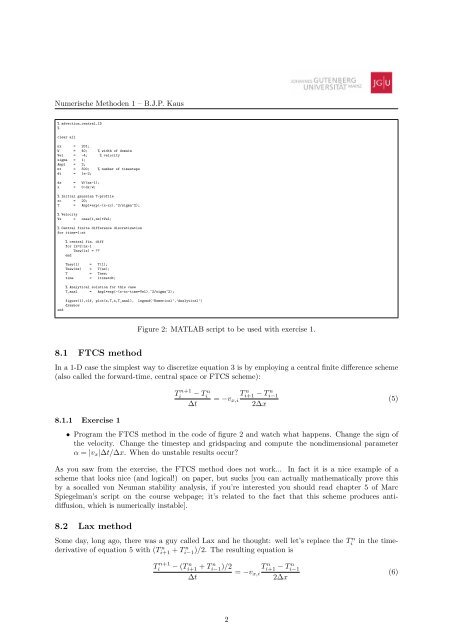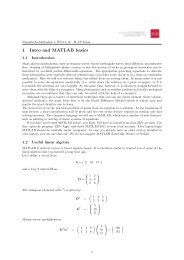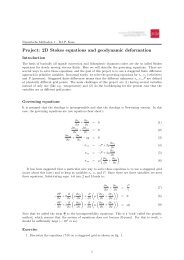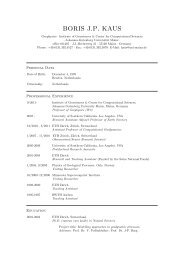8 Advection equations and the art of numerical modeling
8 Advection equations and the art of numerical modeling
8 Advection equations and the art of numerical modeling
- No tags were found...
You also want an ePaper? Increase the reach of your titles
YUMPU automatically turns print PDFs into web optimized ePapers that Google loves.
Numerische Methoden 1 – B.J.P. Kaus% advection_central_1D%clear allnx = 201;W = 40; % width <strong>of</strong> domainVel = -4; % velocitysigma = 1;Ampl = 2;nt = 500; % number <strong>of</strong> timestepsdt = 1e-2;dx = W/(nx-1);x = 0:dx:W;% Initial gaussian T-pr<strong>of</strong>ilexc = 20;T = Ampl*exp(-(x-xc).^2/sigma^2);% VelocityVx = ones(1,nx)*Vel;% Central finite difference discretizationfor itime=1:nt% central fin. difffor ix=2:nx-1Tnew(ix) = ??endTnew(1) = T(1);Tnew(nx) = T(nx);T = Tnew;time = itime*dt;% Analytical solution for this caseT_anal = Ampl*exp(-(x-xc-time*Vel).^2/sigma^2);figure(1),clf, plot(x,T,x,T_anal),drawnowendlegend(’Numerical’,’Analytical’)Figure 2: MATLAB script to be used with exercise 1.8.1 FTCS methodIn a 1-D case <strong>the</strong> simplest way to discretize equation 3 is by employing a central finite difference scheme(also called <strong>the</strong> forward-time, central space or FTCS scheme):T n+1i− Tin∆t= −v x,iT n i+1 − T n i−12∆x(5)8.1.1 Exercise 1• Program <strong>the</strong> FTCS method in <strong>the</strong> code <strong>of</strong> figure 2 <strong>and</strong> watch what happens. Change <strong>the</strong> sign <strong>of</strong><strong>the</strong> velocity. Change <strong>the</strong> timestep <strong>and</strong> gridspacing <strong>and</strong> compute <strong>the</strong> nondimensional parameterα = |v x |∆t/∆x. When do unstable results occur?As you saw from <strong>the</strong> exercise, <strong>the</strong> FTCS method does not work... In fact it is a nice example <strong>of</strong> ascheme that looks nice (<strong>and</strong> logical!) on paper, but sucks [you can actually ma<strong>the</strong>matically prove thisby a socalled von Neuman stability analysis, if you’re interested you should read chapter 5 <strong>of</strong> MarcSpiegelman’s script on <strong>the</strong> course webpage; it’s related to <strong>the</strong> fact that this scheme produces antidiffusion,which is <strong>numerical</strong>ly instable].8.2 Lax methodin <strong>the</strong> time-Some day, long ago, <strong>the</strong>re was a guy called Lax <strong>and</strong> he thought: well let’s replace <strong>the</strong> Tinderivative <strong>of</strong> equation 5 with (Ti+1 n + T i−1 n )/2. The resulting equation isT n+1i − (Ti+1 n + T i−1 n )/2 Ti+1 n = −v − T i−1nx,i∆t2∆x(6)2






